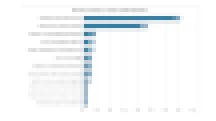Remote instruction may have raised acceptance of school that happens at home. STEM courses in higher education need labs, but that doesn’t mean labs are being used online. And the pandemic year has taken a toll on U.S. education conferences—all in this Edtech Reports Recap.
Home Is Where the Homeschooling Is
Could greater public approval of homeschooling be an unexpected result of the pandemic’s forced experiment in remote online learning? Two surveys make it look that way.
The U.S. Census Bureau’s Household Pulse Survey finds homeschooling rates have more than doubled during the pandemic. The Census Bureau finds that between spring 2020 and fall 2020, the percentage of U.S. households with school-aged children reporting they homeschooled jumped from 5.4 percent to 11.1 percent.
If you’re thinking respondents simply confused remote instruction with homeschooling, apparently the Census Bureau thought they may have, too. So it added a clarification in the second of its two surveys “to make sure households were reporting true homeschooling rather than virtual learning through a public or private school.”
For more evidence of increased pandemic appeal, the Census Bureau notes that while national homeschooling rates grew rapidly from 1999 to 2012, since then they’d held steady at about 3.3 percent.

The Census Bureau surveys were conducted with a nationally representative sample of U.S. households in April/May and September/October 2020. One other notable stat: Black households saw their proportion of homeschooling increase fivefold, from 3.3 percent to 16.1 percent.
Homeschooling shows an additional boost in another survey, this one from the online course review site Learnopoly. The data in its report, “Parents’ Opinions on E-Learning During the Pandemic,” is even more recent than the Census Bureau’s—from March 2021—and is based on a representative sample of 500 U.S. parents with kids ages 4-18 who experienced online learning during the pandemic.
While the majority of the Learnopoly results have to do with opinions about online learning in general, 50 percent of parents surveyed said they now view homeschooling “more favorably or significantly more favorably” than before the pandemic. Twenty-eight percent hadn’t changed their views. The uptick in positive attitudes, the report concludes, “may indicate a transition toward homeschooling, at least in the short term.”

As to online learning overall, Learnopoly’s results find 61 percent of parents whose children have had online learning were “satisfied or very satisfied” with it, and 55 percent view it more favorably than before the pandemic. Lack of social interaction was the biggest downside parents cited for online learning, at 79 percent seeing that as a challenge of the format.
The Most Virtual of Labs? None at All
In higher education, lab work is a key component for students studying the STEM disciplines. But just because faculty need a lab doesn’t mean they use a lab—if that lab has to be online during the pandemic.
A report issued by the Online Learning Consortium (OLC) and Bay View Analytics, “Teaching Online: STEM Education in the Time of COVID,” examined how STEM educators handled the abrupt transition to online instruction. Nearly 900 science, technology, engineering and mathematics faculty members teaching at undergraduate and graduate levels were surveyed in October 2020.
Thirty-five percent of those faculty said they’d had no online course experience before the pandemic. Yet 73 percent converted to emergency remote instruction this past year.
The biggest barrier to online STEM education was the “inability to ensure academic integrity,” cited by 52 percent of respondents. But the top “unique barrier” to STEM online instruction, compared to non-STEM disciplines, was “inadequate online laboratories,” at 72 percent.

So bring on the virtual labs, right? Not so fast. Only 18 percent said they currently used them. A higher number, 35 percent, were aware of them but said they “do not meet my needs.”
“Hands-on or skills-based activities occur in non-STEM disciplines,” the report observes. “Could online practices within fields such as art, dance, or music be adopted into STEM fields, to facilitate a hands-on experience?” Cue the STEAM reference.
See You in September, IRL
Finally, the impact of COVID-19 closures in education goes beyond schools and colleges. It also struck the association and industry conferences that many execs and educators regularly attend. While the consequences for individual learning may not be as great, the stats still stun.
Former EdSurge Managing Editor Tony Wan and I created a Google Sheet on March 18, 2020, the “U.S. Education Industry & Association Conference Status” tracker, shortly after pandemic restrictions slammed SXSW EDU’s 2020 event shut and prompted other conferences to follow suit.
I did a shirtsleeve analysis of the changes to conferences as of March 11, 2021, a date widely considered to be the first anniversary of pandemic lockdowns. Every in-person event on the status tracker in the year since March 11, 2020 has canceled, postponed or gone virtual.
By the numbers:
- For 2020, 79 percent of all tracked events (101 of 128) were affected: 51 percent went virtual and 28 percent canceled.
- For 2021—as of March 11—44 percent of all tracked events (59 of 135) were affected: 38 percent had already gone virtual, 4 percent canceled and 2 percent postponed.
One big, year-to-year change is that many 2021 conferences said they’d be online from the start. And fewer conferences are being canceled outright, instead opting for virtual event platforms that have improved over the past year.
Still, spring is nearly a total loss for in-person events and summer is spotty. Fall starts to see recovery.
“See You in September” may not just be a top ten pop song by The Happenings from 1966. It could be the common refrain about when in-person education conferences will truly return as the pandemic wanes.


